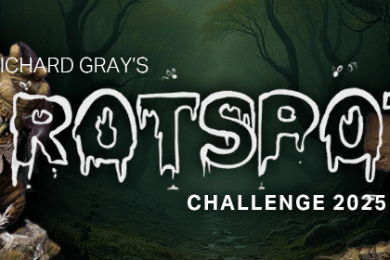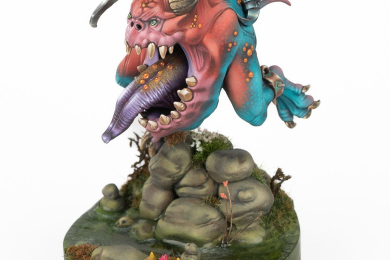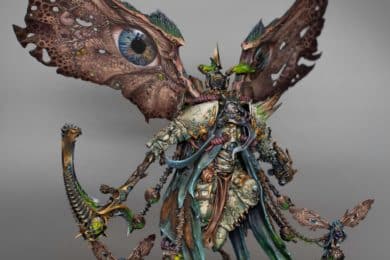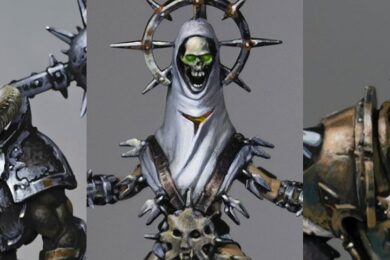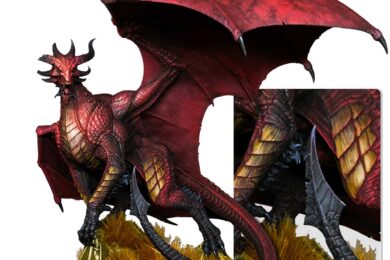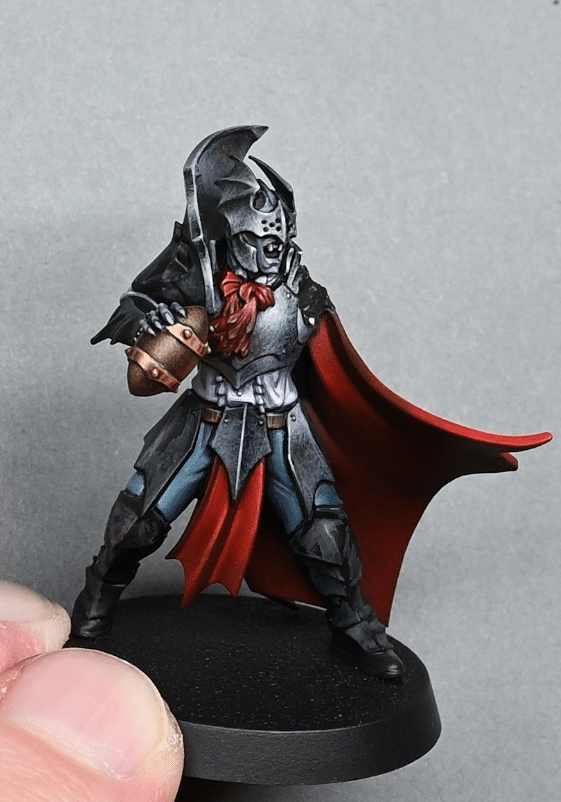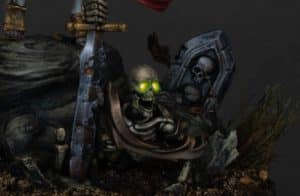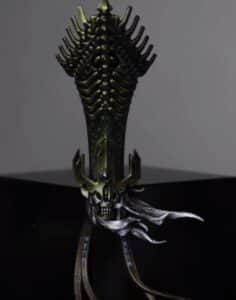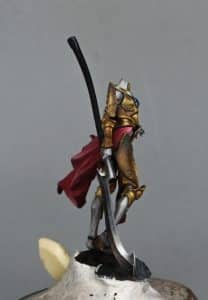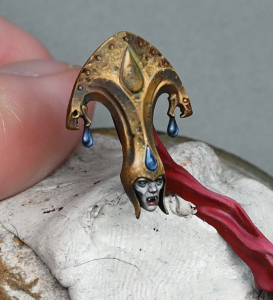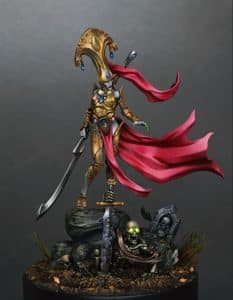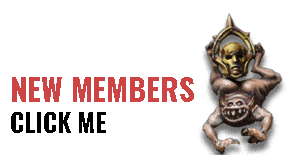A series showing how to paint a Blood Bowl Vampire from the new Vampire Blood Bowl team, which Games Workshop sent me as an early review copy.
Quick Jump to:
Video: How to Paint a Blood Bowl Vampire: Part One
This video focuses on the NMM armour and the wing arm.
Materials Needed:
- Primer: Black
- Paints: Games Workshop: Rhinox Hide, Pink Horror, Sotek Green; Vallejo’s Neutral Grey, Ice Yellow
P3: Morrow White - Brushes: Various sizes, including a worn-out size two for broader strokes and a finer Artist Opus size 00 for details
Step-by-Step Guide
Step 1: Priming
- Start by priming your Blood Bowl Vampire miniature with a black primer. Ensure an even coat to provide a solid base for your paint layers.
Step 2: Painting the Wing Arm
- Begin with the wing arm, using Sotek Green mixed with Pink Horror. Apply this mix following the direction of the wing’s fingers to create a natural flow and texture.
- Gradually add Ice Yellow to the mix for the middle sections of the wing, enhancing the texture and giving depth to the wing membranes.
- Maintain long, directional brush strokes for a consistent and textured appearance, allowing some of the black primer to show through for natural shadows.
Step 3: Non-Metallic Metal (NMM) Armor
- Mix Neutral Grey with a small amount of Rhinox Hide to start creating the base for the NMM effect on the armour.
- Apply this mix to the armor plates, focusing on creating light volumes and highlights. Use a worn-out brush for a more natural, scratchy texture.
- Enhance the NMM effect by adding more Rhinox Hide to the mix for deeper shades and Ice Yellow for brighter highlights. Focus these highlights on areas where light naturally hits the armour, such as the top of the shoulder pads and helmet.
- Use finer brushes for detailed scratch marks and edge highlights to define the armor plates further.
Step 4: Refining Details
- Go back to areas that need more definition or contrast. Use your lighter and darker mixes to refine the textures and highlights on both the wings and armour.
- Pay special attention to edges and areas that would naturally catch more light, increasing contrast and depth.
Step 5: Final Touches
- For the final touches, use Morrow White to add extreme highlights where the light would be strongest, such as the edges of armor plates and the tips of the wings.
- Keep refining until you are satisfied with the contrast and depth.
Video: How to Paint a Blood Bowl Vampire: Part Two
The video focuses on the rest of the model, including the wing, skin, dress shirt etc.
Materials Needed:
- Brushes: Various sizes for different details
- Paints (Games Workshop): Rhinox Hide, Mephiston Red, Evil Sunz Scarlet, Wild Rider Red, Sotek Green, Pink Horror, Mournfang Brown, XV-88, Balor Brown, Kislev Flesh
- Paints (Vallejo): Neutral Grey, Ice Yellow
- Paint (P3): Morrow White
Step-by-Step Guide
Step 1: Cloak and Red Details
- Start by blocking in the cloak and other red details using Mephiston Red. For a darker base, mix Mephiston Red with Rhinox Hide.
- Focus on creating a vibrant red, remembering that areas under shadows or covered by other parts (like wings) will have less visible bright highlights.
- For a consistent look across the model, consider painting all red elements (cloak, necktie, etc.) in similar shades.
Step 2: Armour Panels
- The armour panels are painted to appear weathered. Use Neutral Grey as a base, then layer with lighter greys and whites to create a worn look.
- Avoid bright, shiny finishes, aiming for a contrast between the smoothness of the cloak and the ruggedness of the armour.
Step 3: Skin Tones
- Mix Sotek Green with Pink Horror for the base skin colour, aiming for a slightly greyish tone.
- Layer with increasing amounts of Pink Horror and Ice Yellow for highlights, ensuring a gradual transition for a natural look.
Step 4: Dress Shirt
- Use Demonet Hide as a base for the dress shirt, covering all visible parts.
- Progressively lighten the shirt using Ice Yellow mixed with Demonet Hide, finishing with pure Ice Yellow and Morrow White for the brightest highlights.
- Ensure all recesses are filled with Demonet Hide to avoid harsh contrasts.
Step 5: Wing Membranes
- Initially, create a textured effect on the wings using Pink Horror mixed with Ice Yellow. Apply in parallel lines, paying attention to the curvature of the wings.
- For a smoother finish, blend over these lines with a mix of the base vampire skin colour, softening the texture.
- Paint the wing membranes with Sotek Green, adding patterns in a loose, random fashion for a chaotic look.
Step 6: Ball
- Start with a base of Rhinox Hide, followed by stippling Mournfang Brown and XV-88 for texture. Finish with lighter highlights in XV-88 mixed with Ice Yellow and finally pure Ice Yellow.
- Add a bounce highlight on the underside to add depth and realism.
Step 7: Metallic Rings
- Paint the metallic rings starting with Mournfang Brown, followed by XV-88 for the primary highlight.
- Use a mix of Balor Brown and Ice Yellow for subsequent highlights, finishing with Morrow White for the brightest points.
- Pay attention to edge highlights and add small details on the spikes and rivets for added realism.
Video: How to Paint a Blood Bowl Vampire: Part Three
This video looks at how to paint his red cloak.
Materials Needed:
- Brushes: Size 3 Artist Opus M brush or similar
- Paints (Games Workshop): Rhinox Hide, Mephiston Red, Evil Sunz Scarlet, Wild Rider Red
Step-by-Step Guide
Step 1: Base Coat
- Begin with a base coat of Mephiston Red mixed 50/50 with Rhinox Hide. This creates a deep, dark red that will serve as both a shadow and a base for building highlights.
- Apply this mix over the entire cloak. Note that while it appears vividly red when wet, it dries to a darker, more desaturated shade.
Step 2: Highlighting
- After the base coat dries, apply Mephiston Red to highlight the raised areas of the cloak. This paint appears bright when wet but dulls as it dries.
- Aim for a smooth finish with no texture, contrasting nicely against any textured armour on the model.
- Use multiple coats for an opaque finish, ensuring a solid base for further highlights.
Step 3: Blending
- For a seamless transition, blend Mephiston Red into the shadowed areas, gradually merging into the darker base.
- Use slightly thinner paint for this step, allowing for smooth transitions.
- Focus on maintaining a balance between the bright highlights and darker base.
Step 4: Deepening Shadows
- Enhance the shadows by applying Rhinox Hide to the deepest parts of the cloak, increasing contrast.
- Avoid using straight black for shadows, as it can appear too harsh.
Step 5: Further Highlighting with Evil Sunz Scarlet
- Apply Evil Sunz Scarlet to the brightest parts of the cloak, using a 50/50 water to paint mix initially.
- Increase the opacity with additional layers, focusing on the top of the cloak where light naturally hits.
- Blend this brighter red into the Mephiston Red for smooth transitions.
Step 6: Finishing Touches
- If desired, take the highlights further with Wild Rider Red, applying it sparingly to the sharpest creases and edges for emphasis.
- Avoid using Wild Rider Red on large, smooth areas to prevent the cloak from appearing pink.
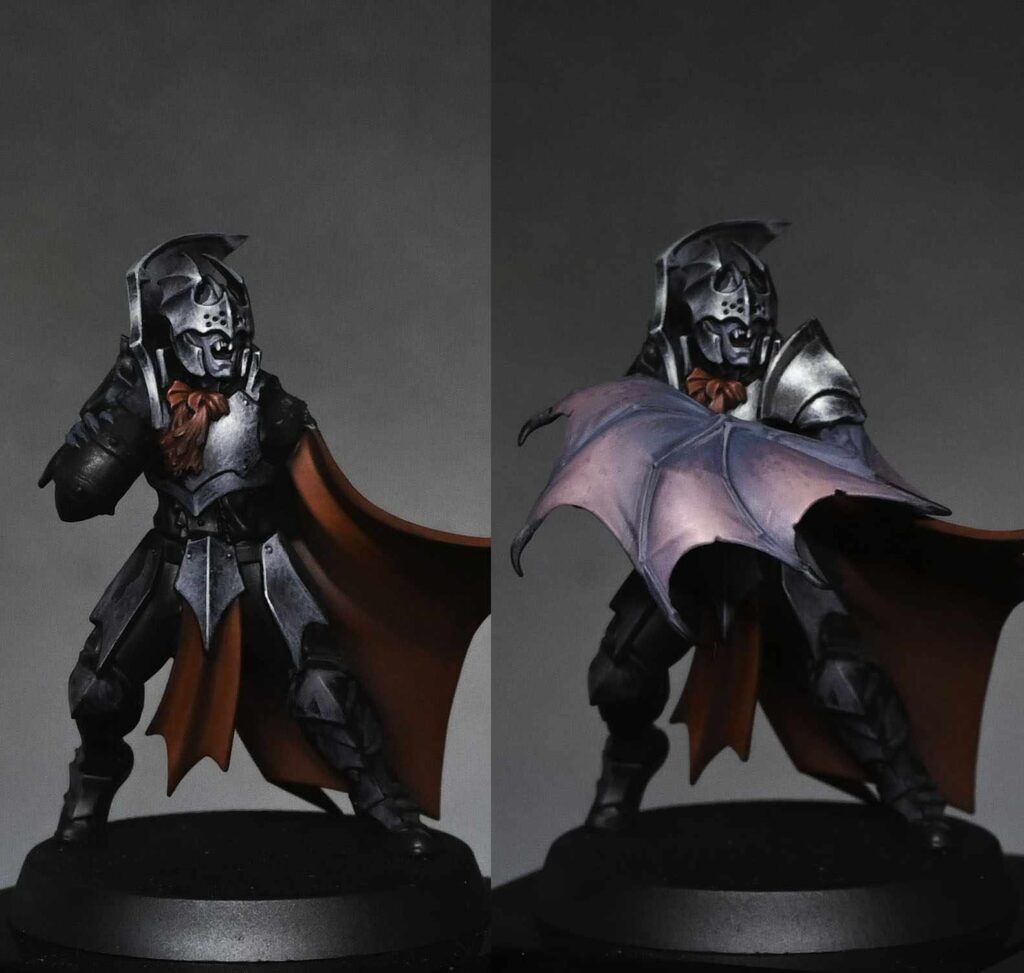
More Vampires and Undead Tutorials to Explore!
If you don’t have an account, please sign up here! The website currently has over 350 video tutorials with steps and tips, plus a selection of PDFs. If you are not sure about joining, you can explore my free videos with a free “freebies” membership, or take the plunge and become a full subscriber for full access.
If you’d prefer to support me on Patreon, please visit: https://www.patreon.com/RichardGray
